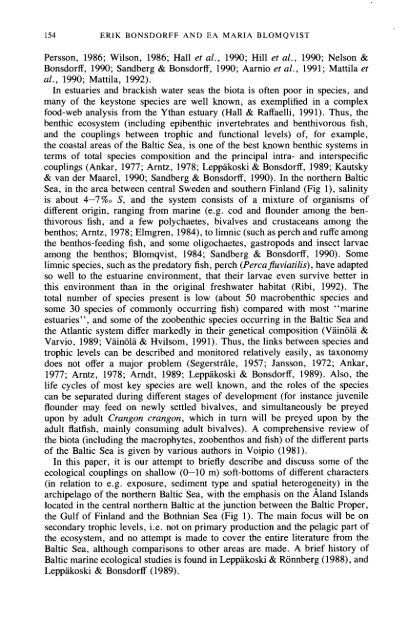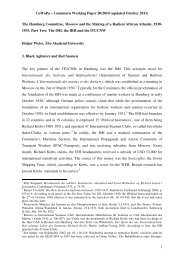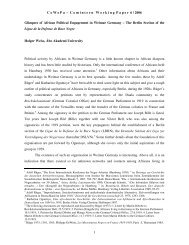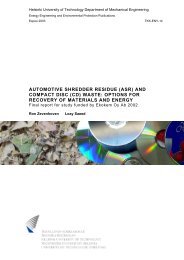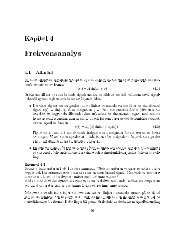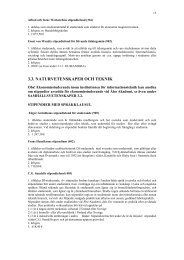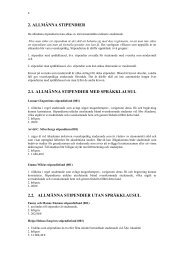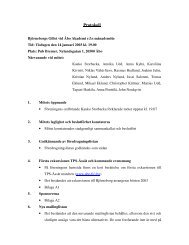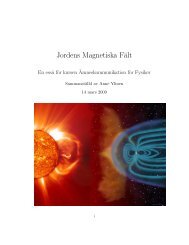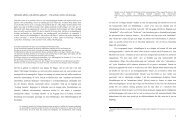biotic couplings on shallow water soft bottoms-examples from the ...
biotic couplings on shallow water soft bottoms-examples from the ...
biotic couplings on shallow water soft bottoms-examples from the ...
You also want an ePaper? Increase the reach of your titles
YUMPU automatically turns print PDFs into web optimized ePapers that Google loves.
154 ERIK BONSDORFF AND EA MARIA BLOMQVIST<br />
Perss<strong>on</strong>, 1986; Wils<strong>on</strong>, 1986; Hall et al., 1990; Hill et al., 1990; Nels<strong>on</strong> &<br />
B<strong>on</strong>sdorff, 1990; Sandberg & B<strong>on</strong>sdorff, 1990; Aarnio et al., 1991 ; Mattila et<br />
al., 1990; Mattila, 1992).<br />
In estuaries and brackish <strong>water</strong> seas <strong>the</strong> biota is often poor in species, and<br />
many of <strong>the</strong> keyst<strong>on</strong>e species are well known, as exemplified in a complex<br />
food-web analysis <strong>from</strong> <strong>the</strong> Ythan estuary (Hall & Raffaelli, 1991). Thus, <strong>the</strong><br />
benthic ecosystem (including epibenthic invertebrates and benthivorous fish,<br />
and <strong>the</strong> <str<strong>on</strong>g>couplings</str<strong>on</strong>g> between trophic and functi<strong>on</strong>al levels) of, for example,<br />
<strong>the</strong> coastal areas of <strong>the</strong> Baltic Sea, is <strong>on</strong>e of <strong>the</strong> best known benthic systems in<br />
terms of total species compositi<strong>on</strong> and <strong>the</strong> principal intra- and interspecific<br />
<str<strong>on</strong>g>couplings</str<strong>on</strong>g> (Ankar, 1977; Arntz, 1978; Leppakoski & B<strong>on</strong>sdorff, 1989; Kautsky<br />
& van der Maarel, 1990; Sandberg & B<strong>on</strong>sdorff, 1990). In <strong>the</strong> nor<strong>the</strong>rn Baltic<br />
Sea, in <strong>the</strong> area between central Sweden and sou<strong>the</strong>rn Finland (Fig I), salinity<br />
is about 4-7%0 S, and <strong>the</strong> system c<strong>on</strong>sists of a mixture of organisms of<br />
different origin, ranging <strong>from</strong> marine (e.g. cod and flounder am<strong>on</strong>g <strong>the</strong> benthivorous<br />
fish, and a few polychaetes, bivalves and crustaceans am<strong>on</strong>g <strong>the</strong><br />
benthos; Arntz, 1978; Elmgren, 1984), to limnic (such as perch and ruffe am<strong>on</strong>g<br />
<strong>the</strong> benthos-feeding fish, and some oligochaetes, gastropods and insect larvae<br />
am<strong>on</strong>g <strong>the</strong> benthos; Blomqvist, 1984; Sandberg & B<strong>on</strong>sdorff, 1990). Some<br />
limnic species, such as <strong>the</strong> predatory fish, perch (Percajuviatilis), have adapted<br />
so well to <strong>the</strong> estuarine envir<strong>on</strong>ment, that <strong>the</strong>ir larvae even survive better in<br />
this envir<strong>on</strong>ment than in <strong>the</strong> original fresh<strong>water</strong> habitat (Ribi, 1992). The<br />
total number of species present is low (about 50 macrobenthic species and<br />
some 30 species of comm<strong>on</strong>ly occurring fish) compared with most "marine<br />
estuaries", and some of <strong>the</strong> zoobenthic species occurring in <strong>the</strong> Baltic Sea and<br />
<strong>the</strong> Atlantic system differ markedly in <strong>the</strong>ir genetical compositi<strong>on</strong> (Vainola &<br />
Varvio, 1989; Vainola & Hvilsom, 1991). Thus, <strong>the</strong> links between species and<br />
trophic levels can be described and m<strong>on</strong>itored relatively easily, as tax<strong>on</strong>omy<br />
does not offer a major problem (Segerstrile, 1957; Janss<strong>on</strong>, 1972; Ankar,<br />
1977; Arntz, 1978; Arndt, 1989; Leppakoski & B<strong>on</strong>sdorff, 1989). Also, <strong>the</strong><br />
life cycles of most key species are well known, and <strong>the</strong> roles of <strong>the</strong> species<br />
can be separated during different stages of development (for instance juvenile<br />
flounder may feed <strong>on</strong> newly settled bivalves, and simultaneously be preyed<br />
up<strong>on</strong> by adult Crang<strong>on</strong> crang<strong>on</strong>, which in turn will be preyed up<strong>on</strong> by <strong>the</strong><br />
adult flatfish, mainly c<strong>on</strong>suming adult bivalves). A comprehensive review of<br />
<strong>the</strong> biota (including <strong>the</strong> macrophytes, zoobenthos and fish) of <strong>the</strong> different parts<br />
of <strong>the</strong> Baltic Sea is given by various authors in Voipio (1981).<br />
In this paper, it is our attempt to briefly describe and discuss some of <strong>the</strong><br />
ecological <str<strong>on</strong>g>couplings</str<strong>on</strong>g> <strong>on</strong> <strong>shallow</strong> (0-10 m) <strong>soft</strong>-<strong>bottoms</strong> of different characters<br />
(in relati<strong>on</strong> to e.g. exposure, sediment type and spatial heterog~eity) in <strong>the</strong><br />
archipelago of <strong>the</strong> nor<strong>the</strong>rn Baltic Sea, with <strong>the</strong> emphasis <strong>on</strong> <strong>the</strong> Aland Islands<br />
located in <strong>the</strong> central nor<strong>the</strong>rn Baltic at <strong>the</strong> juncti<strong>on</strong> between <strong>the</strong> Baltic Proper,<br />
<strong>the</strong> Gulf of Finland and <strong>the</strong> Bothnian Sea (Fig 1). The main focus will be <strong>on</strong><br />
sec<strong>on</strong>dary trophic levels, i.e. not <strong>on</strong> primary producti<strong>on</strong> and <strong>the</strong> pelagic part of<br />
<strong>the</strong> ecosystem, and no attempt is made to cover <strong>the</strong> entire literature <strong>from</strong> <strong>the</strong><br />
Baltic Sea, although comparis<strong>on</strong>s to o<strong>the</strong>r areas are made. A brief history of<br />
Baltic marine ecological studies is found in Leppakoski & R<strong>on</strong>nberg (1988), and<br />
Leppakoski & B<strong>on</strong>sdorff (1989).


